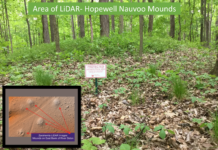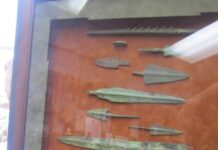Conversion Tools
“From all the evidence in the Book of Mormon, augmented by the testimony of the Prophet Joseph Smith, these final battles took place in the territory known as the United States and in the neighborhood of the Great Lakes and hillsof Western New York. And here Moroni found the resting place for the sacred instruments which had been committed to his care.” Joseph Fielding Smith, Doctrines of Salvation Vol. 3 Ch. 12
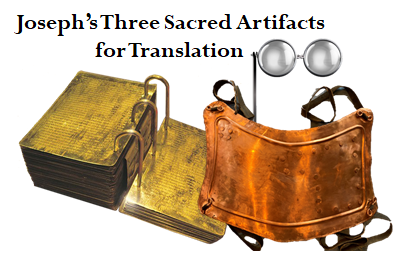
We all know those sacred instruments were the plates, the breastplate and the spectacles, as shown above. This information along with the understanding of Letter VII will be a valuable resource in testifying of the truth to your friends and family.
I believe the Letters written by Oliver Cowdery on request of the Prophet Joseph Smith, contain invaluable information to teach us more about the gospel. The vast majority of members of The Church of Jesus Christ of Latter-day Saints, have never heard about nor read these 8 letters. In my opinion these letters are powerful witnesses of truth that should be read by all.  Most of us were first introduced to these letters because of the deep study of our friend, Jonathan Neville. I t has now been over 7 years since Jonathan wrote his book and I think it is time for us to read it again, or for our first time. You don’t have to read his book to access these 8 Letters but they are found at the Joseph Smith Papers (JSP) Project here:
Most of us were first introduced to these letters because of the deep study of our friend, Jonathan Neville. I t has now been over 7 years since Jonathan wrote his book and I think it is time for us to read it again, or for our first time. You don’t have to read his book to access these 8 Letters but they are found at the Joseph Smith Papers (JSP) Project here:
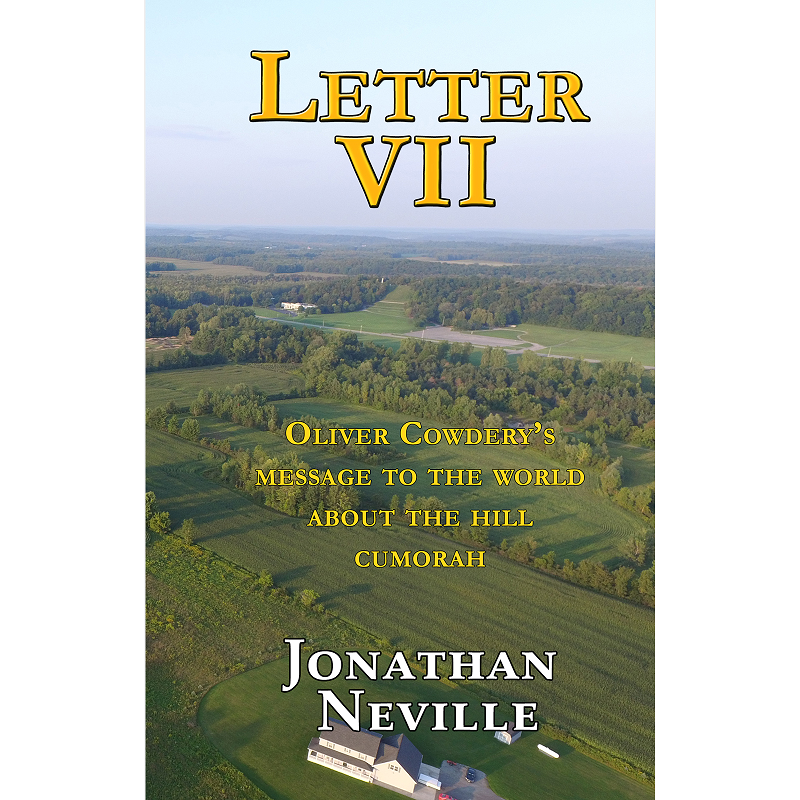
Jonathan’s book makes it so much easier to read, and he offers his commentary throughout. Many people carry Jonathan’s small book often and hand it out as a gift, which I recommend you can do the same.
Sharing the words of these 1835 Letters, is a great missionary tool. For those who say they have to be shown the truth or have it be proven to them, there is a stubbornness in them that is quite frustrating at times. Don’t allow it to steer you from the path of sharing truth with your family and friends who claim there are two Hill Cumorah’s. Share, but don’t force is my motto. People don’t want to be told, rather they want to discover truth for themselves. Be patient as the Lord’s Spirit converts us all, if we ask with a sincere desire.
DID YOU KNOW?
Of Oliver’s eight letters, portions of Letter I are found in our scriptures and canonized?
“See Joseph Smith – History after verse 75.” The source reference is from Messenger and Advocate, vol. 1 (October 1834), pp. 14–16, which is the same thing published as Letter I.
LETTER VII IS PUBLISHED IN THESE PUBLICATIONS: Messenger and Advocate (Kirtland 1835)
Messenger and Advocate (Kirtland 1835)
Copied into Joseph Smith’s Personal Journal (1835)
Quoted in Orson Pratt’s Pamphlet (1840)
Gospel Reflector (Philadelphia 1841)
Times and Seasons (Nauvoo 1841)
The Prophet (New York City 1844-45)
Liverpool Pamphlet (1844)
Millennial Star (1866)
Improvement Era (Salt Lake City 1899)
 “I think Letter VII was reprinted so many times because it was so important. Oliver’s history was the most complete history of the early days of the Church until the serialized History of Joseph Smith began running in the Times and Seasons in 1842, but it was also important for people to know that the New York hill was a touchstone for the Book of Mormon. It was a connection between ancient and modern times–a pin in the map.” Jonathan Neville
“I think Letter VII was reprinted so many times because it was so important. Oliver’s history was the most complete history of the early days of the Church until the serialized History of Joseph Smith began running in the Times and Seasons in 1842, but it was also important for people to know that the New York hill was a touchstone for the Book of Mormon. It was a connection between ancient and modern times–a pin in the map.” Jonathan Neville
Joseph Smith’s History, 1834-1836, contains Oliver’s letters, including Letter VII. You can find it in the Joseph Smith Papers starting with Chapter 1 on page 17. Oliver’s letters appear several pages later. Oliver Cowdery’s Letter VII as it appears in Joseph Smith’s own history “Letter VII,” LDS Messenger and Advocate, July 1835, 1:155–159 (Key to finding letter VII is to scroll down until you find the July 1835 article).
Letter I to Letter VIII Introduction
From the Joseph Smith Papers Project-
History, 1834–1836 Joseph Smith Papers.org
Editorial Note”
 The following section includes transcripts of eight letters Oliver Cowdery wrote in 1834 and 1835 regarding JS’s visions of an angel and his discovery of the gold plates of the Book of Mormon. Cowdery addressed the letters to William W. Phelps and published them as a series in the Latter Day Saints’ Messenger and Advocate between October 1834 and October 1835. The titles and formatting employed in this history are similar to those in the published series of articles, indicating that the Cowdery letters were copied into the history from the Messenger and Advocate, not from a manuscript version of the letters.
The following section includes transcripts of eight letters Oliver Cowdery wrote in 1834 and 1835 regarding JS’s visions of an angel and his discovery of the gold plates of the Book of Mormon. Cowdery addressed the letters to William W. Phelps and published them as a series in the Latter Day Saints’ Messenger and Advocate between October 1834 and October 1835. The titles and formatting employed in this history are similar to those in the published series of articles, indicating that the Cowdery letters were copied into the history from the Messenger and Advocate, not from a manuscript version of the letters.
Frederick G. Williams could have begun the transcription in JS’s history as early as 6 December 1834, the date of Cowdery’s last historical entry in the preceding section of the history. However, Cowdery probably gave the history to Williams around 2 October 1835, when he gave Williams JS’s journal. On 29 October 1835, JS retrieved the history from Williams and delivered it to Warren Parrish, who continued copying the Cowdery letters. It is likely that Parrish finished copying the letters by early April 1836, when he gave JS’s journal (and presumably the 1834–1836 history along with it) to Warren Cowdery
In the first letter, Oliver Cowdery recounted his experiences with JS beginning when the two first met in April 1829. The letter includes an account of the vision he and JS had of John the Baptist, who gave them the authority to baptize. After composing this letter, but before its publication, Cowdery developed a new history-writing plan: he decided that in subsequent letters he would relate the “full history of the rise of the church,” beginning with JS’s early life and visions. As editor of the Messenger and Advocate, Cowdery prefaced the published version of the first letter with an explanation (also transcribed into the history) of the new plan. Although he had no firsthand knowledge of church history prior to April 1829, Cowdery assured his readers that “our brother J. Smith Jr. has offered to assist us. Indeed, there are many items connected with the fore part of this subject that render his labor indispensable.” Some passages in the ensuing narrative seem to have been related to Cowdery by JS, since Cowdery recounts events in which only JS participated.
Cowdery composed the letters to inform the Latter-day Saints of the history of their church, but he also wrote for the non-Mormon public. Employing florid romantic language, frequent scriptural allusions, and much dramatic detail, he clearly intended to present a rhetorically impressive account of early Mormon history. He placed the rise of the church in a dispensational framework, characterizing the time between the end of the New Testament and JS’s early visions as a period of universal apostasy.
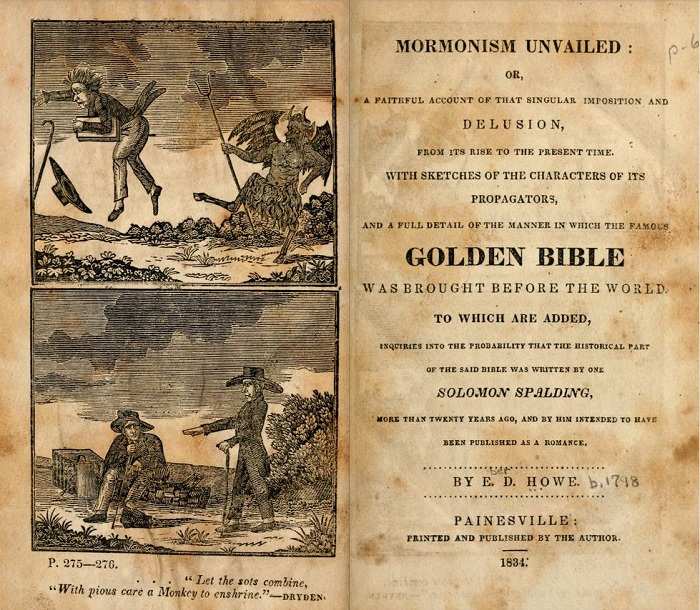
He included the revivalism of various denominations during the Second Great Awakening, which JS experienced in his youth, as an example of the doctrinal confusion and social disharmony present in Christendom. Throughout the series of letters, he defended JS’s character and that of the Smith family, and his explicitly apologetic statements include apparent allusions to both Alexander Campbell’s Delusions (1832) and Eber Howe ’s Mormonism Unvailed (1834).
Beginning in the third letter, Cowdery provided the most extensive account of the origins of the Book of Mormon published up to that time. He related JS’s initial visions of the angel Moroni and, using biblical prophecies, elaborated on the angel’s message concerning the gathering of Israel in the last days in preparation for the Millennium. Cowdery continued his narrative up to, but did not include, JS’s receiving the gold plates in September 1827.
The transcription of the Oliver Cowdery letters into JS’s history was evidently conceived in terms of the entire series, not as a piecemeal copying of the individual letters. As noted above, Cowdery probably gave the “large journal” containing the history begun in 1834 to Williams in October 1835, the month of the Messenger and Advocate issue in which his final installment was published.
By the time Williams received the history, Cowdery may have already written the final letter; he had at least conceived of it as the final installment in his series. With the serialized Cowdery letters complete or nearing completion, the new history kept in the “large journal” could serve as a repository—more permanent than unbound newspapers—for a copied compilation of the entire series.

Letters from Messenger and Advocate
The following communication was designed to have been published in the last No. of the star; but owing to a press of other matter it was laid over for this No. of the Messenger and ad[v]ocate. Since it was written, upon further reflection, we have thought that a full history of the rise of the church of the Latter Day Saints, and the most interesting parts of its progress, to the present time, would be worthy the perusal of the Saints.— If circumstances admit, an article on this subject will appear on in each subsequent No. of the Messenger and advocate, until the time when the church was driven from Jackson Co. Mo. by a lawless banditti; & such other remarks as may be thought appropriate and interesting.
That our narrative may be correct, and particularly the introduction, it is proper to inform our patrons, that our brother J. Smith Jr. has offered to assist us. Indeed, there are many items connected with the fore part of this subject that render his labor indispensable. With his labor and with authentic documents now in our possession, we hope to render this a pleasing and agreeable narrative, well worth the examination and perusal of the Saints.
To do <Justice to> this subject will require time and space: we therefore ask the forbearance of our readears, assuring them that it shall be founded upon facts.
From Letter VII we hear the most precise indication of the true location of the Hill Cumorah and that this same hill was indeed the location of the final battles of the Nephites and Lamanites. It is quoted below from the middle of the letter to the end.
Oliver Cowdery, “Letter VII,” October 1835
“At about one mile west rises another ridge of less height, running parallel with the former, leaving a beautiful vale between. The soil is of the first quality for the country, and under a state of cultivation, which gives a prospect at once imposing, when one reflects on the fact, that here, between these hills, the entire power and national strength of both the Jaredites and Nephites were destroyed.
By turning to the 529th and 530th pages of the book of Mormon120 you will read Mormon’s account of the last great struggle of his people, as they were encamped round this hill Cumorah. (it is printed Camorah, which is an error.) In this vally fell the remaining strength and pride of a once powerful people, the Nephites—once so highly favored of the Lord, but at that time in darkness, doomed to suffer extermination by the hand of their barbarous and uncivilized brethren. From the top of this hill, Mormon, with a few others, after the battle, gazed with horror upon the mangled remains of those who, the day before, were filled with anxiety, hope or doubt. A few had fled to the South, who were hunted down by the victorious party, and all who would not deny the Saviour and his religion, were put to death. Mormon himself, according to the record of his son Moroni, was also slain.
But a long time previous to this disaster it appears from his own account, he foresaw approaching destruction. In fact, if he perused the records of his fathers, [p. 86] which were in his possession, he could have learned that such would be the case. Alma, who lived before the coming of the Messiah, prophesies this.121 He, however, by divine appointment, abridged from those records, in his own style and language, a short account of the more important and prominent items, from the days of Lehi to his own time, after which he deposited, as he says, on the 529th page, all the records in this same hill, Cumorah and after gave his small record to his son Moroni, who, as appears from the same, finished, after witnessing the extinction of his people as a nation.
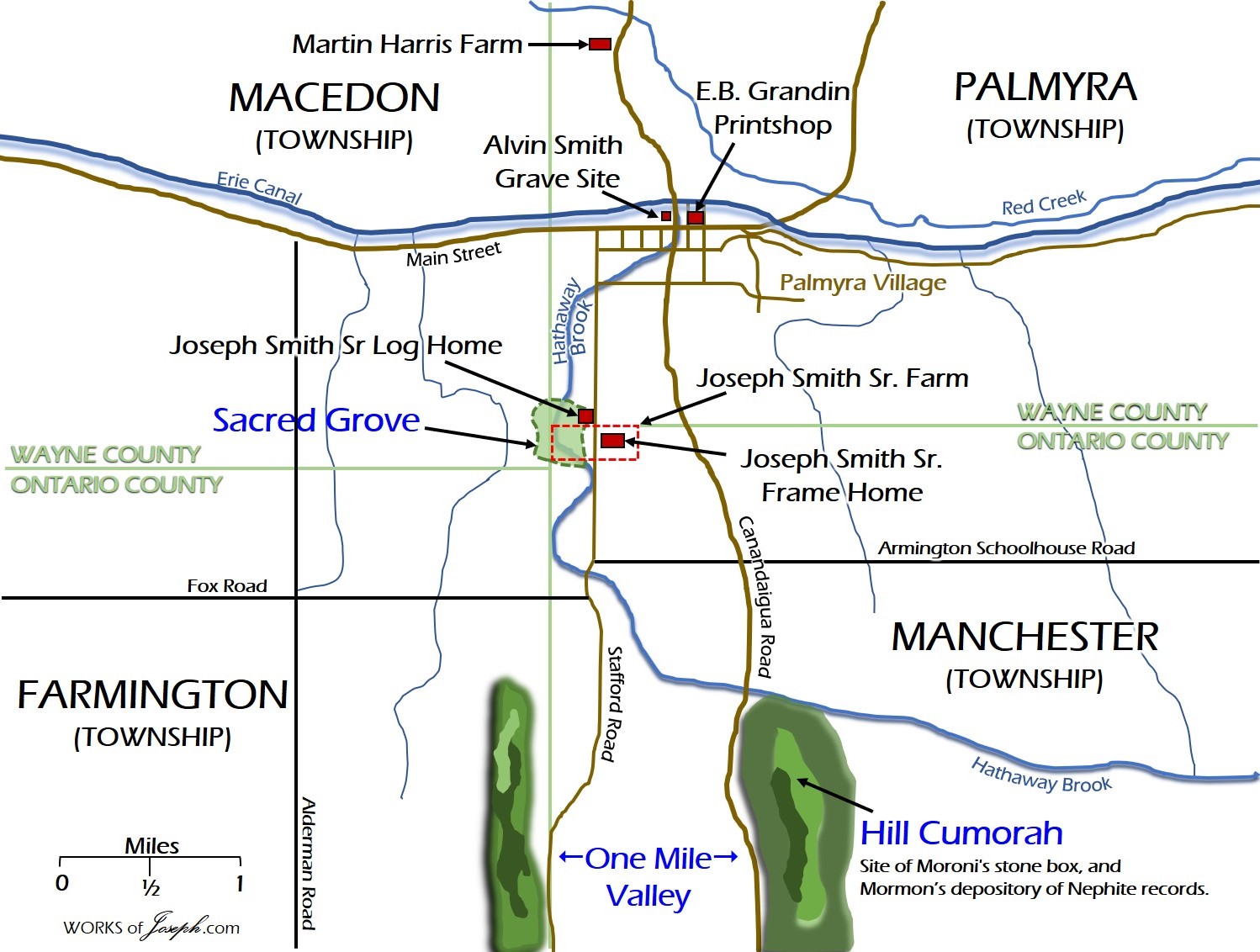
It was not the wicked who overcame the righteous; far from this: it was the wicked against the wicked, and by the wicked the wicked were punished.—122 The Nephites who were once enlightened, had fallen from a more elevated standing as to favour and privilege before the Lord in consequence of the righteousness of their fathers, and now falling below, for such was actually the case, were suffered to be overcome, and the land was left to the possession of the red men, [North American, not Central American Lamanites] who were without inteligence, only in the affairs of their wars; and having no records, only preserving their history by tradition from father to son, lost the account of their true origin, and wandered from river to river, from hill to hill, from mountain to mountain, and from sea to sea, till the land was again peopled, in a measure, by a rude, wild, revengful, warlike and barbarous race.— Such are our indians.
This hill, by the Jaredites, was called Ramah: by it, or around it pitched the famous army of Coriantumr their tents.123 Coriantumr was the last king of the Jaredites The opposing army were to the west, and in this same vally, and near by, from day to day, did that mighty race spill their blood, in wrath, contending, as it were, brother against brother, and father, against son. In this same spot, in full view from the top of this same hill, one may gaze with astonishment upon the ground which was twice covered with the dead and dying of our fellow men. Here may be seen where once sunk to nought the pride and strength of two mighty nations; and here [p. 87] may be contemplated, in solitude, while nothing but the faithful record of Mormon and Moroni is now extant to inform us of the fact, scenes of misery and distress—the aged, whose silver locks in other places and at other times would command reverence; the mother, who in other circumstances would be spared from violence; the infant, whose tender cries would be regarded and listened to with a feeling of compassion and tenderness; and the virgin, whose grace, beauty and modesty, would be esteemed and held inviolate by all good men and enlightened and civilized nations, alike disregarded and treated with scorn!—in vain did the hoary head and man of gray hairs ask for mercy; in vain did the mother plead for compassion; in vain did the helpless and harmless infant weep for verry anguish, and in vain did the virgin seek to escape the ruthless hand of revengeful foes and demons in human form—all alike were trampled down by the feet of the strong, and crushed beneath the rage of battle and war! Alas, who can reflect upon the last struggles of great and populous nations, sinking to dust beneath the <hand of Justice and retribution without> weeping over the corruptions of the human heart, and sighing for the hour when the clangor of arms shall no more be heard, nor the calamities of contending armies no more experience<d> for a thousand years? Alas, the calamities calamity of war, the extinction of nations,124 the ruin of kingdoms, the fall of empires and the disolution of governments! O the misery, distress and evil attendant on these! Who can contemplate like scenes without sorrowing, and who so destitute of commiseration as not to be pained that man has fallen so low, so far beneath the station in which he was created?
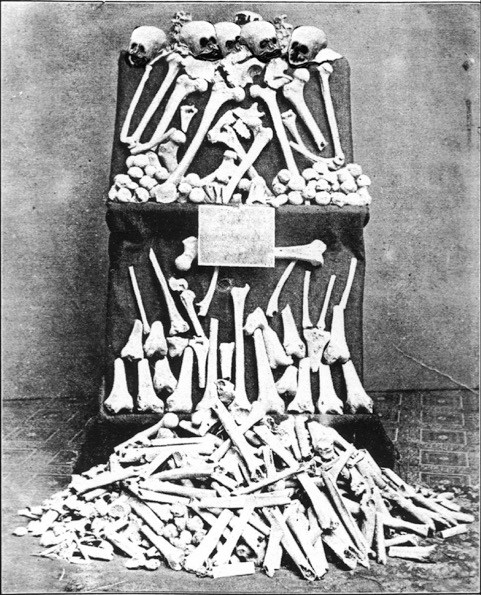
In this vale lie commingled, in one mass of ruin the ashes of thousands, and in this vale was destined to consume the fair forms and vigerous systems of tens of thousands of the human race—blood mixed with blood, flesh with flesh, bones with bones and dust with dust! When the vital spark which [p. 88] animated their clay had fled, each lifeless lump lay on one common level—cold and inanimate. Those bosoms which had burned with rage against each other for real or suposed injury, had now ceased to heave with malice; those arms which were, a few moments before nerved with strength, had alike become paralized and those hearts which had been fired with revenge, had now ceased to beat, and the head to think—in silence, in solitude, and in disgrace alike, they have long since turned to earth, to their mother dust, to await the august, and to millions, awful hour, when the trump of the Son of God shall echo and reecho from the skies, and they come forth, quickened and immortalized, to not only stand in each other’s presence, but before the bar of him who is Eternal!
With sentiments of pure respect, I conclude by subscribing myself, your brother in the gospel, Oliver Cowdery.
Oliver Cowdery, “Letter VII,” October 1835 [parenthesis, color, italics added]
The Plates, Breastplate, and Spectacles

The other day I was reading from the Wentworth Letter, when I read a quote by Joseph Smith saying, “With the records was found a curious instrument'”
I immediately thought, “Yes, that unique pair of spectacles attached to a breastplate is very curious.” I didn’t think, wow, that rock and a hat was curious. That didn’t even cross my mind. I thought how strange to think the translation with a stone found in a well by Joseph many years earlier, being put in a so-called top-hat, was not curious, it was strange to me.
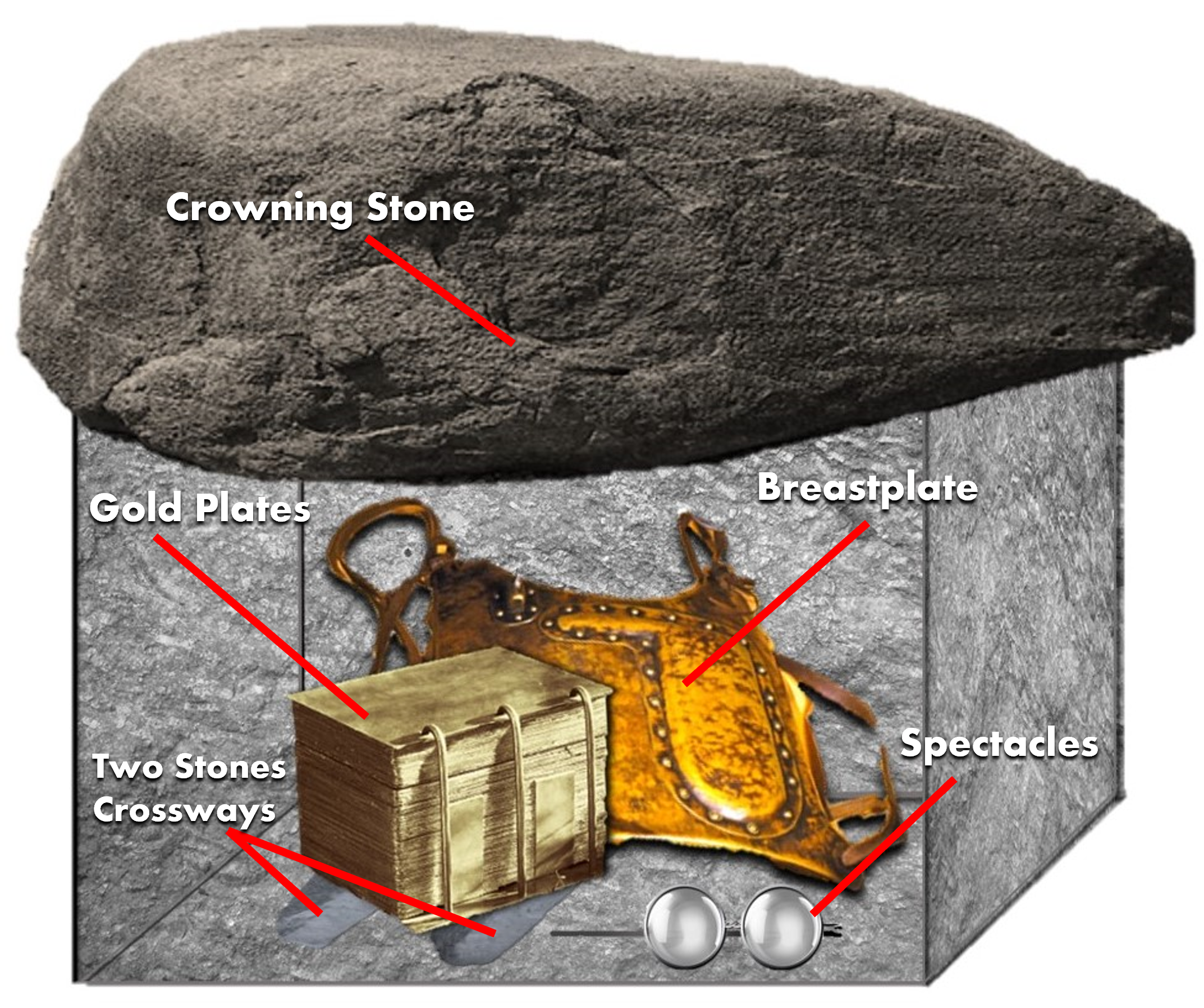 With my love of Joseph Smith and the Lord’s method of translation, that word of “curious” hit me in a way I hadn’t realized before. I sat back and pondered that word for a minute, and almost immediately recalled in my mind time and time again, where I had heard that word in the scriptures. As I began looking up quotes about the word “curious“, I found an outstanding reason to write a blog about that word. What is the Lord telling us in scripture, when He attaches the word “Curious” as an adjective to other words?
With my love of Joseph Smith and the Lord’s method of translation, that word of “curious” hit me in a way I hadn’t realized before. I sat back and pondered that word for a minute, and almost immediately recalled in my mind time and time again, where I had heard that word in the scriptures. As I began looking up quotes about the word “curious“, I found an outstanding reason to write a blog about that word. What is the Lord telling us in scripture, when He attaches the word “Curious” as an adjective to other words?
The word “Curious” also invoked words like, unusual, unique, not ordinary, special and then I decided to hear what the dictionary said about this word. Here is what Merriam said:
Oliver Cowdery, Letter VIII Said,
“The manner in which the plates were deposited: First, a hole of sufficient depth, (how deep I know not) was dug. At the bottom of this was laid a stone of suitable size, the upper surface being smooth. At each edge was placed a large quantity of cement, and into this cement, at the four edges of this stone, were placed, erect, four others, their bottom edges resting in the cement at the outer edges of the first stone. The four last named, when placed erect, formed a box, the corners, or where the edges of the four came in contact, were also cemented so firmly that the moisture from without was prevented from entering. It is to be observed, also, that the inner surface of the four erect, or side stones was smoothe. This box was sufficiently large to admit a breast-plate, such as was used by the ancients to defend the chest, &c. from the arrows and weapons of their enemy. From the bottom of the box, or from the breast-plate, arose three small pillars composed of the same description of cement used on the edges; and upon these three pillars was placed the record of the children of Joseph, and of a people who left the tower far, far before the days of Joseph… I must not forget to say that this box, containing the record was covered with another stone, the bottom surface being flat and the upper, crowning. But those three pillars were not so lengthy as to cause the plates and the crowning stone to come in contact. I have now given you, according to my promise, the manner in which this record was deposited; though when it was first visited by our brother, in 1823, a part of the crowning stone was visible above the surface while the edges were concealed by the soil and grass, from which circumstances you will see, that however deep this box might have been placed by Moroni at first, the time had been sufficient to wear the earth so that it was easily discovered when once directed, and yet not enough to make a perceivable difference to the passer-by.” Oliver Cowdery, “Letter VIII,” October 1835


“Having removed the earth, I obtained a lever, which I got fixed under the edge of the stone, and with a little exertion raised it up. I looked in, and there indeed did I behold the plates, the Urim and Thummim [“Lights and Perfections” or allegorically, “Doctrine and Truth”; see pp. xix, 446, 560-61, 551], and the breastplate, as stated by the messenger. The box in which they lay was formed by laying stones together in some kind of cement. In the bottom of the box were laid two stones crossways of the box, and on these stones lay the plates and the other things with them.” JSH 1:52
What Do You Think?
I think it is most likely there were two stones on the bottom crossways of the box as this is canonized information. The Letter VIII information is a good secondary witness that there was something that the plates were sitting on top of such as the three pillars.
Lucy Mack Smith in her History also mentions she thought there were 4-Pillars as you will read below. I’m sure it doesn’t mater if there were two, three, or four, but had you even realized before reading this blog, that there were some number and type of cement stones on which the gold plates was sitting?

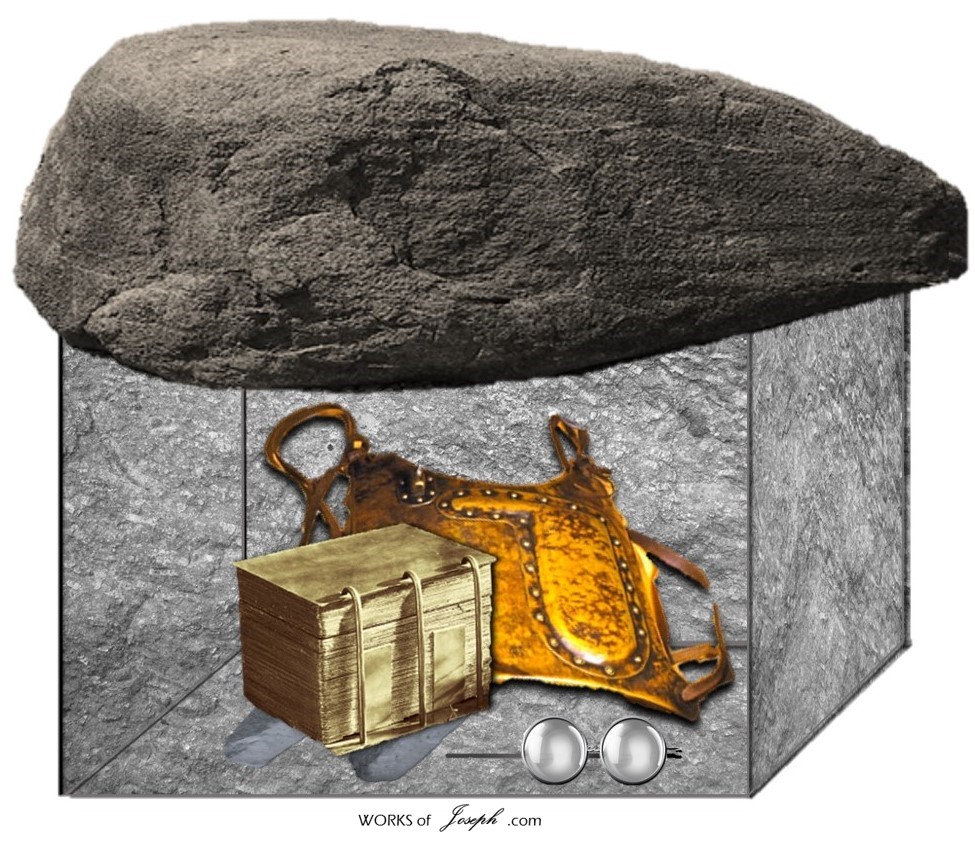
 The Very Stone that Laid on Top of the Box
The Very Stone that Laid on Top of the Box
“Years ago, when the church was working on filming “How Rare A Possession,” (See Video Here) the Church contacted brother [L…] in our stake. [Le…] was quite a well-known, successful landscaper in the area (I also dated his son). They asked him if he could locate a rock that would be as close to the dimensions of the rock that would have covered the stone box where the plates were deposited. [L…] took this task VERY seriously and read the entire BofM in three days (morning and night). At around 3AM, just as he finished the last page, he knelt down in prayer and asked the Lord to guide him to such a rock. Upon finishing his supplication he heard a voice tell him to go to the Hill at that moment. He lived about 45 minutes from the Hill. By the time he arrived, the sun was just starting to rise. He said within 15 minutes he was directed to a spot on the Hill and as he peered down he noticed a tip of a rock jutting out of the hillside. As he started to dig, he realized how large this stone truly was. Then he heard another voice tell him, this is THE stone....the very stone that laid on top of the box. He immediately stopped his digging and decided to contact the Church. Upon calling them to tell them he believes he found THE stone, the brother told him that they knew and already had 4 men on a flight out there to meet with him and that he was to wait until they got there before removal of the stone. He said it took 5 men to lift the stone. The stone was used in the filming of the movie and is currently kept in the granite vaults in UT. You may be aware from your historical research that the actual stone box was reported by Oliver Cowdery that “the casket had been washed down to the foot of the Hill.” Thus, the box is no longer.” Kathy Burris as told in an email to Rod Meldrum. See complete blog here.

“Years ago, when the church was working on filming “How Rare A Possession,” (See Video Here) the Church contacted brother [L…] in our stake. [Le…] was quite a well-known, successful landscaper in the area (I also dated his son). They asked him if he could locate a rock that would be as close to the dimensions of the rock that would have covered the stone box where the plates were deposited. [L…] took this task VERY seriously and read the entire BofM in three days (morning and night). At around 3AM, just as he finished the last page, he knelt down in prayer and asked the Lord to guide him to such a rock. Upon finishing his supplication he heard a voice tell him to go to the Hill at that moment. He lived about 45 minutes from the Hill. By the time he arrived, the sun was just starting to rise. He said within 15 minutes he was directed to a spot on the Hill and as he peered down he noticed a tip of a rock jutting out of the hillside. As he started to dig, he realized how large this stone truly was. Then he heard another voice tell him, this is THE stone....the very stone that laid on top of the box. He immediately stopped his digging and decided to contact the Church. Upon calling them to tell them he believes he found THE stone, the brother told him that they knew and already had 4 men on a flight out there to meet with him and that he was to wait until they got there before removal of the stone. He said it took 5 men to lift the stone. The stone was used in the filming of the movie and is currently kept in the granite vaults in UT. You may be aware from your historical research that the actual stone box was reported by Oliver Cowdery that “the casket had been washed down to the foot of the Hill.” Thus, the box is no longer.” Kathy Burris in an email to Rod Meldrum 2015. You can see the entire email at the blog below:


